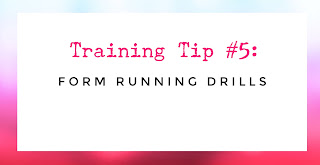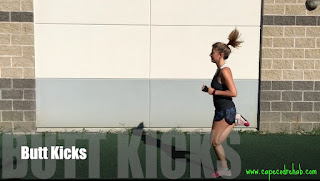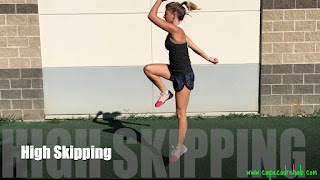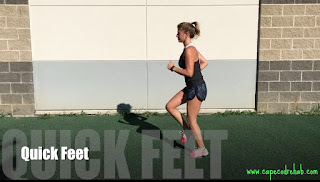and efficiency is by practicing form drills.
It is very common that your running form can break down with fatigue and
any change in stride will increase your chance of injury. Form running drills exaggerate different
elements of the running stride to increase range of motion, build strength and
develop muscle memory for important movement patterns.
When should you perform form running
drills?
training 2-3x per week. They should
be done after your warm up/dynamic warm up and before your workout.
Do not perform any exercise that causes or increases pain.
High Knees
drive to develop strength in the quads and hip flexors.
lifting your knees upward until your thigh is at least parallel to the ground.
Foot strikes should be soft and near the balls of your feet.
Butt Kicks
the hamstring muscles firing and emphasize the recovery phase—also known as the
follow through. Tight or weak hamstrings can lead to more of a shuffle stride
with a low heel kick and shorter gait.
towards your glutes as you keep your thighs perpendicular to the ground.
High Skipping
knee drill but skipping also incorporates calf and hamstring power along with
increased ankle stability.
Skip forward focusing on height and soft landings. As you drive up off the
ground, lift your opposite arm overhead.
Quick Feet
teaching your muscles to fire and turnover at a faster rate. Bonus! Quick feet
is an excellent drill for over-striders.
if you are running on hot coals. You should be running more on the balls of
your feet and don’t worry about your high knees and butt kicks—just speed and
quickness!
Backwards Running
muscles. It strengthens the quads while promoting good posture.
on standing up tall and take long strides landing on the balls of your feet.
Carioca
almost performed exclusively in a straight line moving forward but it is very
important to train laterally. The Carioca exercise (also known as the
grapevine) works on hip mobility and lateral stability.
in front of the other, step out to the side, then cross your leg behind the
other, step out to the side. Swing your arms side to side and your hips should
be rotating as well. Start out slow and increase your speed as you get the hang
of it. Don’t forget to repeat the exercises leading with the other leg!
About
Coach Jen Skiba
Jen began her running career as a
middle-distance runner for Falmouth High School and has been involved with the
sport for over 12 years as a runner, official, race management, and coach. A Mashpee Fitness trainer and Certified
Running Coach through the Road Runners Club of America (RRCA), Jen enjoys
working with runners in the gym and on the roads. “Whether you are a beginner
looking to get started running or at the intermediate level hoping to improve
your times or tackle new distances, I can help you reach your goals!”








